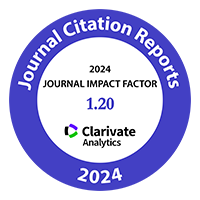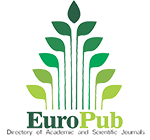First Report of the Black Soybean Weevil Rhyssomatus subtilis Fiedler (Coleoptera: Curculionidae) in Córdoba, Argentina. Crop Damage Estimation
Keywords:
damaged pods, yield losses, distribution, Glycine maxAbstract

The black soybean weevil is an endemic pest in northwestern and northeastern Argentina, causing significant damage. The objective of this study was to confirm the presence of this species in Córdoba, describe symptomatology and evaluate the potential impact on the crop. Surveys were conducted in plots located in the north-central part of the province. Individuals were collected and a quantitative assessment of symptoms and damage was conducted. Twenty compound samples were taken from sectors showing different physiological appearances (green vs. yellowish). In each group, total pod number and damaged pod number allowed calculating damage percentage. Data were analyzed by ANOVA and Fisher's test (α = 0.05). All collected individuals matched the morphological descriptions reported in the literature for the species Rhyssomatus subtilis Fiedler. Green plants had a higher proportion of damaged pods (0.89) and fewer pods (31.85) compared to yellowish plants (0.53 and 46.65, respectively). This relationship suggests a direct effect on biomass partitioning. Our finding remaps the pest’s distribution range, warning areas of high agricultural production in Córdoba and raising the need to link public-private actions to minimize its spread.
Highlights:
- First record of Rhyssomatus subtilis in soybean fields in Córdoba Province, Argentina. The black soybean weevil was detected in five sites in the central-northern region, where no previous records existed.
- Detection was triggered by reports of pod damage. Identification was based on characteristic injury and the collection of larvae and adults, confirmed with expert input and literature.
- Damage assessment revealed physiological differences in affected plants. Severely damaged plants showed delayed senescence and symptoms consistent with green stem disorder.
- Pod injury by subtilis significantly reduced pod set. Statistical analysis showed marked differences in the number of pods between high- and low-damage areas.
- The presence of subtilis poses a new threat to soybean production in Córdoba. Its rapid spread and high damage potential call for increased monitoring and management attention.
Downloads
References
Aragón, J. & Imwinkelried, JM. (2007). Manejo integrado de plagas de la alfalfa. En DH Basigalup (Ed.), El cultivo de la alfalfa en la Argentina, (p. 165-197). Ediciones INTA - EEA Manfredi.
Bolsa de Cereales de Córdoba. (2024). Informe de campaña agrícola 2023/2024. https://www.bccba. org.ar
Casuso, M., Tarragó, J., Cazado, L., Casmuz, A., Cancino, C., Soneira, D., & Gullini, L. (2022). Registro de Rhyssomatus subtilis Fiedler (Coleoptera: Curculionidae) en la zona de El Caburé (Santiago del Estero) sobre los cultivos de soja Glycine max (L.) Merr. y algodón (Gossypium hirsutum). INTA Las Breñas.
Casuso, VM, Cancino, CA, Tarragó, JR, & Pérez, GA (2023). Primeras evaluaciones para conocer el comportamiento del picudo negro de la soja Rhyssomatus subtilis Fiedler (Coleoptera: Curculionidae) en el este de Santiago del Estero. En XXVIII Reunión de Comunicaciones Científicas, Técnicas y de Extensión. Universidad Nacional del Nordeste, Facultad de Ciencias Agrarias. p. 38. https://repositorio.unne.edu.ar/ handle/123456789/55928
Cazado, LE, Casmuz, AS, Scalora, F., Murúa, MG, Socías, MG, Gastaminza, GA, & Willink, E. (2014). El picudo negro de la soja, Rhyssomatus subtilis Fiedler (Coleoptera: Curculionidae). Avance Agroindustrial, 35(4), 55-60.
Di Rienzo, JA, Balzarini, M., Casanoves, F., Gonzalez, L., Tablada, M., Robledo, CW. (2010). InfoStat, Software Estadístico. Universidad Nacional de Córdoba, Argentina.
Egli, DB, & Bruening, WP. (2006). Depodding causes green-stem syndrome in soybean. Crop Management, 5(1), 1-5. https://doi.org/10.1094/CM-2006-0104-01-RS
Fehr, WR, & Caviness, CE. (1977). Stages of soybean development (Special Report N° 80). Iowa State University Cooperative Extension Service.
Ferreira, AB, de Almeida, MR, & Dias, WP. (2010). Incidência de Aphelenchoides besseyi em cultivares de soja com sintomas de “soja louca”. Nematologia Brasileira, 34(1), 39-45.
Fiedler, C. (1937-1938). Neue südamerikanische Arten der Gattung Rhyssomatus Schönh. (Col. Curc. Chryptorhynch.). Entomologisches Nachrichtenblatt (Troppau), 12: 81-96.
Lanteri, AA, del Río, MG, & Marvaldi, AE. (2002). Curculionoidea (Coleoptera). In LE Claps, J. Morrone & MC Roig-Juñent (Eds.), Biodiversidad de artrópodos argentinos, 1: 327-349. Ediciones Sur.
Peralta, CR. (2022). Congreso N°30 AAPRESID: Un congreso a suelo abierto. Tecnologías para el manejo integrado de insectos.
Rotundo, JL, Salvagiotti, F., & Andrade, FH. (2012). Physiological and management causes of the green stem disorder in soybean. Field Crops Research, 134: 186-195.
Salvagiotti, F., Rotundo, JL, & Pereyra, VR. (2020). Advances in understanding the green stem disorder in soybean. Revista de la Facultad de Agronomía, 119(1), 1-9.
Socías, MG, Rosado-Neto, GH, Casmuz, AS, Zaia, DG, & Willink, E. (2009). Rhyssomatus subtilis Fiedler (Coleoptera: Curculionidae), primer registro para la Argentina y primera cita de planta hospedera, Glycine max (L) Merr. Revista Industrial y Agrícola de Tucumán, 86(1): 43-46.
Wibmer, GJ, & O’Brien, CW. (1986). Annotated checklist of the weevils (Curculionidae sensu lato) of South America. Memoirs of the American Entomological Institute, 39: 1-563.

Published
How to Cite
Issue
Section
License
Copyright (c) 2018 Revista de la Facultad de Ciencias Agrarias UNCuyo

This work is licensed under a Creative Commons Attribution-NonCommercial-ShareAlike 3.0 Unported License.
Aquellos autores/as que tengan publicaciones con esta revista, aceptan las Políticas Editoriales.












.jpg)




